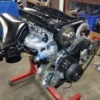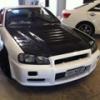Oil Control For My Rb
Announcements
-
Similar Content
-
Latest Posts
-
H2 (for cars) will never happen. It's not reasonable for any number of reasons. It's also not reasonable for almost all of the industrial uses that the fanbois say that it will be used for, again for a large number of reasons. There are some cases where it will be good. But, even those will be massively hampered by the economics. The only way that H2 can be economic is if we somehow manage to get from where we are to the other side of the economic-valley-of-death in which no-one can operate. You need there to be sufficient renewable generated electricity to be available so that it is effectively free. Once you are there, you can do whatever the hell you want and hang the efficiency. But until you get there, the ever diminishing value of electricity makes it harder and harder to encourage businesses to build the new generation capacity, and they will simply stop investing in generation projects. (I kinda think there needs to be just government money spent on building the required capacity in a non-commercial way, similar to how the first fossil fueled grids were built, as national-government owned utilities. And probably some nuclear in there to start. But this all should have started 10-15 years ago to avoid the chasm of death that we face right now). Synth fuels will be much more likely, but will only occur is there is at least some renewable H2 production, because you need H2 to do it. And you need stacks of free (or at least extraordinarily cheap) energy because assembling molecules back into fuels is exactly the opposite process to burning the fuel, and the reason we burn fuels is because there is so much energy squeezed into each molecule. So you're somewhat subject to the same economic valley of death problem as above anyway. That is unless people are willing to pay the current equivalent of $5 or $6 per litre of petrol-ish liquid fuels. Can you imagine it? The squealing at $2 now is bad enough.
-
This is so cool. Get a dashcam that records audio and hopefully you'll catch it. Maybe there's a brand or some kind of markings on the back ? Are the pics hand drawn? I love it so much.
-
Hahaha yep, point(s) taken. I just like seeing different things and an EV in an R32 is pretty different. I'm not on the EV band wagon, I'm waiting for synthetic fuels or hydrogen personally.
-
No, only I do the disciplining.
-
I mean it's probably likely that people overestimate their skills in dialling in a setup and noticing the changes. I had SK shocks and springs, and added heavier springs and got them revalved by Sydney Shocks to suit based upon what I told them I wanted the car to handle like. I got back a completely different feeling set of shocks, which probably (?) feel great on track but holy hell are they rough on tram tracks and the like. The shock dyno actually looks pretty similar to Shockworks (from what I can surmise from a screenshot of a youtube video - and my dyno printout...) Truth be told I doubt I'd be any faster or slower with either setup, or camber/castor combination. I also had whiteline eccentric castor bushes up front of my R34. I removed them and put in poly non-adjustable ones to soothe my OCD (nobody ever set the castor the same side to side, and it'd be near impossible to do) and be happy the wheel is centered in the well now for clearance reasons. Yes I wanted it to move 1mm 'back' :p I've effectively set my castor back to stock, negating all the benefits of that which is supposedly massive. I've probably also altered toe and camber in a negative (detrimental) way. I can't tell any difference steering the car.
-







Recommended Posts
Create an account or sign in to comment
You need to be a member in order to leave a comment
Create an account
Sign up for a new account in our community. It's easy!
Register a new accountSign in
Already have an account? Sign in here.
Sign In Now